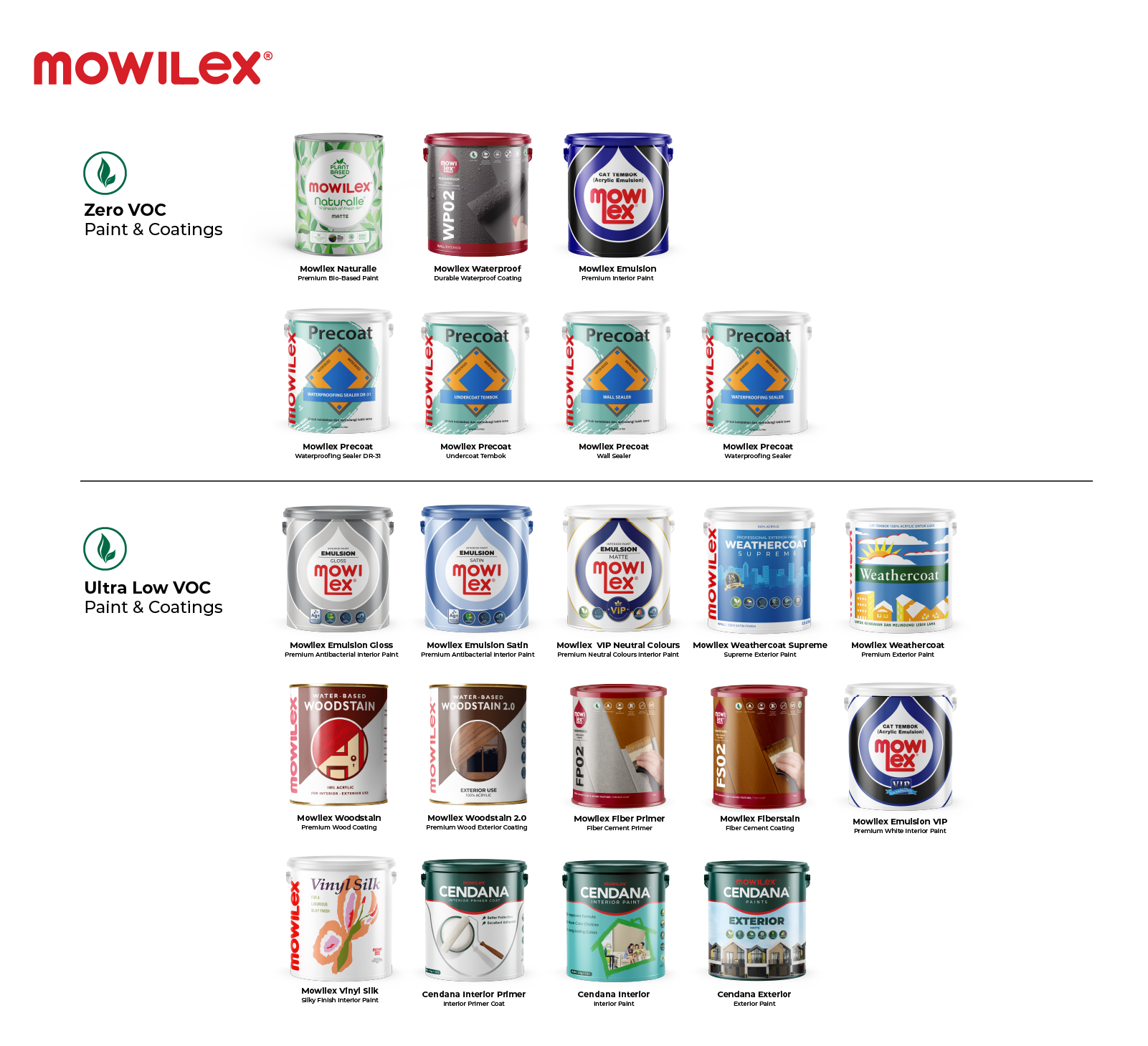A Volatile Organic Compound (VOC) is a solid or liquid containing carbon that evaporates at room temperature. Air contains numerous VOCs, some of which are natural and some man-made. Natural VOCs are generally emitted from trees and vegetation or biogenic sources while man-made VOCs are largely from vehicle emissions, unburned/evaporated gasoline and solvents. Used by some regulatory bodies around the world as a term to improve air quality, a VOC in one country may not be regarded as VOC in another one.
Emissions from architectural and decorative coatings generally account for less than 1% of total VOCs in the air. Responsible for how paint molecules bind together and adhere to the wall, the solvents/thinners in paints are responsible for VOC emissions.
Indonesia doesn’t define VOCs under current regulations. Therefore, there are no guidelines for labeling paints and coatings based on their VOC content. Mowilex’s labeling rules are based on the air quality standards adopted by California’s South Coast Air Quality Management District (SCAQMD) that has set VOC limits for various coatings, effective January 1st, 2019. A world leader in setting environmental standards, California’s VOC limits are up to five times lower than even those of the US Environmental Protection Agency (USEPA) in some cases. For comparison, SCAQMD’s limit for general decorative and architectural coatings is 50 g/L, but the USEPA’s is 250 g/L.
The simple answer is no. In 1970, Mowilex became the first to manufacture water-based paints in Indonesia. In the past, typical solvent-based paints had VOC levels of up to 450 g/L, or even higher. And even today, some water-based paints have VOC levels of up to 250 g/L. With material advancements and advanced formulations, many of our paints have VOC levels at or below 50 g/L, which is the low VOC limit for decorative paints in California.
Nearly all our paints are water-based, not solvent-based. All of Mowilex’s latex-based paints that use water as a solvent are non-toxic. The VOCs emitted from those products contain no toxic air contaminants. Many paint manufacturers continue to use ethylene glycol (EG) – a designated toxic compound – as a cosolvent in latex paints. However, all our products are EG Zero™. We use a non-toxic propylene glycol substitute that is commonly found in food, cosmetics, and pharmaceuticals.
VOC is usually measured as grams per liter (g/L), the weight of VOC per volume of product. It can also be measured as released emission in micrograms per cubic meter of wet paint (µg/m3). For instance, the USEPA and European Environment Agency (EEA) measure air pollution concentrations in µg/m3 while they typically limit product emissions to a g/L measure.
We use several approaches to measure the VOC content of our products. These include tests by independent laboratories such as TÜV, calculating VOC based on the disclosed VOC content of the raw ingredients we use, and testing and certification by The Ministry of Ecology (Ministère de la Transition écologique et solidaire) of France, which uses micrograms per cubic meter (µg/m3) released over specific time intervals in their approach. VOC is commonly measured before any colorant is added in shops.
Mowilex’s products that have maximum VOC levels of 40 g/L are labeled “Ultra Low VOC.” These levels are 20% lower than those prescribed by SCAQMD for coatings. With a VOC content of 41-75 g/L, our “Low VOC” products have emissions that are higher than “Ultra Low VOC” but are still 70% lower than the USEPA limit. As of 2019, all our products are either “Ultra Low VOC” or “Zero VOC.”
Nothing is ever completely VOC free. Trace amounts of VOCs can be found even in drinking water in some places in the United States. Mowilex has set the limit for “Zero VOC” at or better than the generally accepted “Non-Detect” level of 5 g/L following California’s SCAQMD Rule 314 exemption for “Zero VOC” equivalent coatings.
We also apply the same standards to our outdoor paints when many others have a higher tolerance for emissions of outdoor products. For instance, even with emissions of only 8 g/L, we label our WEATHERCOAT exterior paint as “Ultra-Low VOC” though it is closer to the “Zero VOC” level for indoor paints. Also, our Emulsion and WP02 Waterproof products, among many others, are “Zero VOC”.
VOCs are the primary sources of odor in paints. Therefore, VOCs and odors are highly correlated – lower the VOC content, lesser the odor. The odor that we get after painting is that of VOCs that evaporate from wet paint and it stays till the film is dry.
Many different compounds are considered VOCs and while some are toxic, others are not. Many paint manufacturers continue to use ethylene glycol (EG) – a designated toxic compound – as a cosolvent in latex paints.

